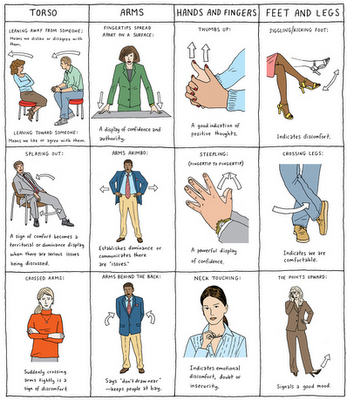Are you worried? Are you confused about how to present your body language in the best way? Here are some tips to improve your body language and present yourself in a more confident way.
Imagine yourself facing an interview and the interviewer analyzing you in detail. You have to present yourself with the best body language to impress the interviewer and get the job. Body language is always important when you want to make an impression on someone like your employer, client, girlfriend or associates.
Human behavior is quite interesting to observe and interpret. The way how you interact with others and communicate your thoughts to them gives them a fair idea of your personality. It often happens, while in a discussion, we sometimes unconsciously communicate our opinions, thoughts, beliefs, and perspectives without even giving a serious thought on what they actually convey. Usually, non-verbal cues account for 90% of human communication. Sounds somewhat unbelievable, but it is true!
That may sound strange is that inapt body language is likely to create miscommunication and misinterpretations. Others are also likely to get a wrong hint of your personality at times. It is, therefore, highly essential to develop a powerful body language so that people perceive your cues correctly.
The tips below will supplement your understanding of body language signs and will help you in grooming your personality further. So, let’s explore how to improve your body language.
Eye Contact
Maintaining proper eye contact is one of the important ways to improve your body language. This is one of the most important aspects of your body language when you are dealing with some people whom you have just met. Eye contacts also indicate that you are showing interest in what they are saying and also giving respect to their opinion. They will also feel more comfortable and a sense of genuine comfort while they are in your company. So keep eye contact more than 60% of the time when you are in company with the person.
Body Language For Dummies by Elizabeth Kuhnke.
Posture
If you get your posture right, you will feel better instantly. Also, your sitting or standing position has some effect on your mood and feelings. So ensure that you are using the proper posture when you are talking with some other person.
Head, Arms, and Legs Positions
You can feel confident and self-assured by keeping your head level horizontally and vertically. You have to keep your head straight if you want to be authoritative and want the other person to take seriously what you are saying. While in conversation tilt your head a little to any of the sides to make the listener feel friendly. Just like your head, the posture of your arms indicates your openness and receptiveness of the person you are meeting. Always try to make a balance between your slow and fast arm movement by keeping your arms midway. But don’t cross your hands at the front as it is considered as a sign of disagreement. Always try to put your legs still as legs tend to move around comparatively more when someone is nervous, stressed or being deceptive. Also, ensure that your knees or ankles are not crossed. Also, don’t bring your leg up to rest in on your knees as the posture is considered more defensive in nature.
Body Angles
The angle of your body in relation to others indicates your attitude and feelings towards them. Normally people angle towards the other when they like people and angle themselves away when they do not like the other person. So ensure that you put your body in a proper angle by tilting to of from the other person in a balanced way to avoid any negative indication to the other person.
Hand Gestures
Your hand gestures indicate a large number of things. For instance, slightly up and open palms are considered open and friendly whereas palm down gestures are normally considered as dominant, emphasizing and possibly aggressive. These up and down gestures of palms are of great importance when you are shaking hands with the other person. It is always better to offer an upright and vertical handshake as it is considered as a sign of equality.
Distance from the Other Person
Your distance from the other always sends some sign to the other person. When you stand too close to the other person you are considered pushy whereas by standing too far away from the other person you are considered keeping your distance. So ensure that you are neither too close nor too far away from the people when you meet them in a group. Also, ensure that you have not moved too closer to someone that he has to back away indicating that you have overstepped the mark and entered into his personal space.
Correct and Confident Postures
The first thing that people usually take notice of in you is your posture. Your posture plays a very significant role in determining your attitude and other competencies. Whether you stand tall or slouch, tells the person, you are communicating to, a lot of things about your personality. Slouchers tend to demonstrate an unfriendly and unpleasant approach. Slouching is not only awful for your body, but is also not favorable for your image. Others might also assume that either you are ill, shy, indifferent or insecure. On the contrary, people who stand tall exude an air of confidence and seem pleasantly approachable. It gives a perception to people that you a friendly and easy-going person. Standing with a straight back adds more points to your personality and always keeps you up for a good time.
The Definitive Book of Body Language by Barbara Pease and Allan Pease.
Head Angles
Your head angles are also an important determinant for people to judge your character and personality. The angle of your head, while in a conversation, has a lot to say about your interest and involvement in the particular conversation. Avoid staring at the ground or looking sideways while in a discussion as this may convey a negative message to your spectators. Always keep your chin and eye level upright. Take care not to tilt your head to the back as this conveys a sign of arrogance. Keeping your head leveled with the ground makes you appear down-to-earth and friendly. Do not keep your head constantly steady and do give a few head tilts at intervals to communicate that your interests are active in the conversation.
Hand Signals
Avoid talking with your hands in excess. Hand signals are acceptable but seem indecent when used in excess. It is crucial to understand the use of hand signals for communicating our views. The placement of our hands is also equally important in everyday conversations. We should be very careful about our hand signals as at times they may lead to conflicting perceptions. Keeping your palms up communicates that you have an open mind while palms down connote that you have a very arrogant attitude. Try to orienting your palms inward while active in discussions and this demonstrates that you have a very friendly and sportive personality. Pointing your finger at someone is the most disliked hand signal as this depicts a very hostile attitude. Crossing your arms is often a formal body language, but keeping this posture steady might make your audience perceive that you seem to be stubborn.
Handshakes
Handshake is usually the first gesture you give upon meeting someone. It also gives an immediate impression to people of how confident you are. The grip and temperature of your hands speak a lot about your energy and confidence levels. A weak grip is a sign of insecurity and nervousness whereas having a good grip is a sign of wisdom and confidence. Placement of the palm is another important component of this form of body language. Handshakes ooze an air of comfort so you should be very particular of your palm position while shaking hands. Keeping your palm down is a very uncommon gesture and should be avoided unless you rank a very high position of power. Keeping your palm vertical to that of the person’s palm expresses your sense of respect and implies equal footing. The time of handshake is also an important aspect to keep in mind. Shaking your hand three to five times is generally acceptable. In case, you are shaking hands with someone who is superior to you, then wait until the other person retracts his hand; this is usually considered as a sign of respect.
Alertness
We display many such body language signs that let people know how alert we are. Alertness is a key trait of a good listener. Alertness doesn’t only mean your attentiveness to the discussion, but it refers to how you capture the incoming body language signs. If you are alert, you tend to understand what exactly the other person is trying to convey you. Being a good listener is definitely a positive trait, but staying alert to body language signs is also equally important. Alertness often helps us in understanding the nonverbal cues of people, communicating with us. Yawning a very bad sign while amidst a discussion as this makes people perceive that you lack interest in the discussion. This can sometimes be annoying for people and sometimes can even hurt their sentiments. So stay alert to let people know how well you are connecting to them.

3 responses to “How to Improve Your Body Language”
May I use your body language chart for a training on hospitality? If you would like, I can also include a link to your article.
Thanks for your help.
Sure you can, Jesica! Would appreciate a link back. Thanks!
Awesome article! Shaking hands correctly creates the very first impression during the interview. If done correctly, it sends a positive signal to the prospective employer.